
Here are some details about the top 10 most beautiful historical sites for tourists in Norway.
1. Bryggen (Bergen) Norway
2. Akershus Fortress (Oslo) Norway
3. Nidaros Cathedral (Trondheim) Norway
4. Viking Ship Museum (Oslo) Norway
5. Urnes Stave Church (Luster) Norway
6. Røros Mining Town Norway
7. Borgund Stave Church Norway
8. Heddal Stave Church Norway
9. Kongsvinger Fortress Norway
10. Lysefjord and Pulpit Rock (Preikestolen) Norway
1. Bryggen (Bergen) Norway
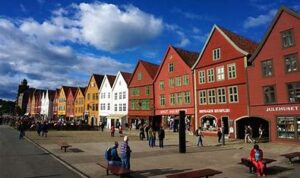
Bryggen, located in Bergen, Norway, is one of the UNESCO World Heritage and most beautiful historical Sites and attracts tourists seeking a glimpse into the city’s rich past.
This iconic waterfront district is characterized by its colorful wooden buildings, which date back to the Hanseatic period of the 14th century.
Visitors to Bryggen can not only wander through the narrow alleyways and cobblestone streets, but also immerse themselves in the charming atmosphere of this well-preserved medieval district.
The buildings, with their distinctive gabled facades, not only house a variety of shops, galleries, and cafes, but also provide tourists with opportunities to shop for traditional Norwegian handicrafts, sample local cuisine, and admire local artwork.
History buffs will appreciate the opportunity to learn about Bergen’s maritime heritage at the Hanseatic Museum, located within one of the historic buildings in Bryggen.
The museum offers insight into the lives of the Hanseatic merchants who once inhabited the district and provides a fascinating glimpse into Bergen’s trading history.
For panoramic views of Bryggen and the surrounding area, tourists can climb the nearby Fløyen Mountain or take a scenic boat tour along the city’s picturesque waterfront.
Additionally, visitors can explore nearby attractions such as the Bergen Fish Market, the Bergenhus Fortress, and the Funicular Railway for a well-rounded experience of this vibrant city.
In conclusion, Bryggen in Bergen, Norway, offers tourists a unique blend of history, culture, and stunning architecture.
Its picturesque waterfront setting, historic buildings, and vibrant atmosphere make it a must-visit destination for travelers looking to immerse themselves in the charm of Norway’s past.
2. Akershus Fortress (Oslo) Norway
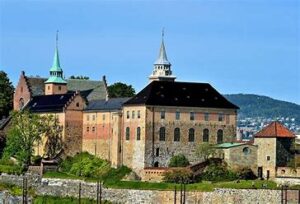
Akershus Fortress, located in Oslo, Norway, is one of the most beautiful historical sites that offers tourists a glimpse into the country’s rich past and stunning architecture.
Originally built in the late 13th century, the fortress has served various purposes throughout its history, including as a royal residence, military stronghold, and prison.
Visitors to Akershus Fortress can not only explore its well-preserved medieval structures, but also admire the imposing stone walls, towers, and ramparts that offer panoramic views of Oslo and the Oslofjord.
The fortress also houses several museums and exhibitions that showcase Norway’s military history, royal heritage, and cultural traditions.
One of the highlights of a visit to Akershus Fortress is the opportunity to witness the daily changing of the guard ceremony, where soldiers in traditional uniforms march in precision to the sound of military music.
This ceremonial tradition not only adds to the historical ambiance of the fortress, but also provides visitors with a unique cultural experience.
For tourists interested in learning more about the fortress and its significance, guided tours are available in multiple languages.
These tours not only offer insights into the fortress’s history and architecture, but also highlight the important role it has played in shaping Norway’s identity.
After exploring the fortress, visitors can then stroll through the surrounding grounds, which not only feature lush gardens and statues, but also offer scenic walking paths.
The nearby waterfront promenade offers picturesque views of the harbor and is a perfect spot for taking in the beauty of Oslo’s waterfront.
In conclusion, Akershus Fortress is a must-visit destination for tourists seeking to immerse themselves in Norway’s history and culture.
Its impressive architecture, historical significance, and scenic surroundings make it a captivating attraction for visitors of all ages.
3. Nidaros Cathedral (Trondheim) Norway
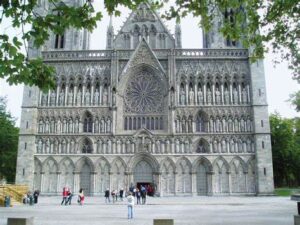
Nidaros Cathedral, one of the most beautiful historical sites in Trondheim, Norway for tourists, is one of the magnificent Gothic masterpieces of great historical importance and cultural significance.
As the northernmost medieval cathedral in the world, Nidaros Cathedral is not only a must-visit destination for tourists, but also an essential site for those seeking to explore Norway’s rich architectural heritage.
Constructed over the course of several centuries, Nidaros Cathedral is dedicated to St. Olav, the patron saint of Norway.
The cathedral’s intricate facade features not only stunning rose windows and spires, but also sculptures that showcase the craftsmanship of medieval artisans.
Visitors can admire the detailed carvings and ornate decorations that adorn the cathedral’s exterior, providing a glimpse into Norway’s medieval past.
Inside Nidaros Cathedral, tourists will find a serene and awe-inspiring interior that is not only filled with beautiful stained glass windows and vaulted ceilings, but also adorned with historic artifacts.
The cathedral’s main altar, adorned with intricate wood carvings and religious iconography, is a focal point for visitors seeking a moment of reflection and contemplation.
Guided tours of Nidaros Cathedral are readily available for tourists who are not only interested in learning more about the cathedral’s history, but also eager to explore its architecture and significance.
These tours provide insight into the cathedral’s role as a pilgrimage site and its importance in Norwegian religious and cultural traditions.
After exploring Nidaros Cathedral, tourists can wander through the surrounding grounds, which include a peaceful cemetery and the Archbishop’s Palace.
Nearby attractions such as the Old Town Bridge and the Nidaros Pilgrim Centre offer additional opportunities for visitors to immerse themselves in Trondheim’s rich history and culture.
In conclusion, Nidaros Cathedral is a must-see destination for tourists visiting Trondheim, Norway.
4. Viking Ship Museum (Oslo) Norway
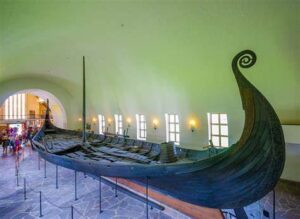
The Viking Ship Museum in Oslo, Norway, is a fascinating destination and one of the most beautiful historical sites for tourists seeking to immerse themselves in the rich history and culture of the Viking Age.
Located on the Bygdøy peninsula, the museum is home to three remarkably well-preserved Viking ships that date back over a thousand years.
Visitors to the Viking Ship Museum can marvel at the intricately carved wooden vessels, which the Vikings used for both burial and ceremonial purposes. The ships, known as the Oseberg,
Gokstad, and Tune ships, are accompanied by a wealth of artifacts and archaeological finds that provide insight into the lives and customs of the Vikings.
In addition to the impressive ships on display, the museum also features interactive exhibits and multimedia presentations that bring the Viking Age to life.
Visitors can learn about Viking navigation, trade, and warfare, as well as the cultural and religious practices of this ancient seafaring civilization.
For those looking to delve deeper into Viking history, guided tours are available in multiple languages, offering in-depth explanations of the museum’s exhibits and the significance of the Viking ships.
The museum’s knowledgeable staff are also on hand to answer questions and provide additional information to enhance visitors’ understanding of the Viking Age.
After exploring the museum, tourists can take a leisurely stroll along the picturesque coastline of Bygdøy, where they can enjoy stunning views of the Oslo Fjord and visit other nearby museums and cultural attractions.
Overall, the Viking Ship Museum offers a captivating and educational experience for tourists interested in delving into the fascinating world of the Vikings.
5. Urnes Stave Church (Luster) Norway
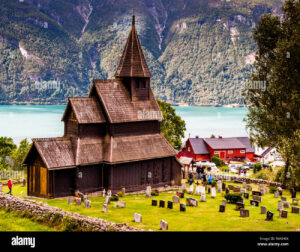
Urnes Stave Church, located in Luster, Norway, is one of the most beautiful historical and UNESCO World Heritage Sites for tourists and one of the oldest and most well-preserved stave churches in the country.
Dating back to the 12th century, this medieval wooden church is a remarkable example of Scandinavian architecture and craftsmanship.
Tourists visiting Urnes Stave Church can expect to be transported back in time as they marvel at the intricate carvings, ornate decorations, and unique design of this historic structure.
The church’s exterior features intricate wooden carvings depicting scenes from Norse mythology, Christian symbolism, and everyday life in medieval Norway.
Inside the church, visitors will find a serene and atmospheric space that is not only adorned with beautiful frescoes, but also enhanced by intricate wooden sculptures.
The interior of Urnes Stave Church is a testament to the skill and artistry of the craftsmen who built it centuries ago.
Guided tours of Urnes Stave Church are available for tourists who are not only looking to learn more about the history of this architectural gem, but also eager to understand its significance.
Knowledgeable guides provide valuable insights into the church’s construction; furthermore, they delve into its cultural and religious importance, as well as the fascinating stories behind its intricate carvings.
Surrounded by lush greenery and overlooking the picturesque Lustrafjorden, Urnes Stave Church offers visitors a peaceful and scenic setting to explore and appreciate Norway’s rich cultural heritage.
After visiting the church, tourists can take a leisurely stroll through the surrounding grounds, enjoy a picnic by the fjord, or explore the charming village of Luster.
In conclusion, Urnes Stave Church is essential for tourists wanting to explore Norway’s medieval past and cultural heritage.
6. Røros Mining Town Norway
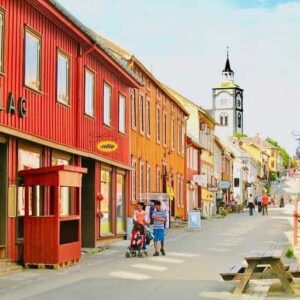
Røros Mining Town, located in Norway, is also one of the most beautiful historical and UNESCO World Heritage Sites that offers tourists a glimpse into the country’s rich mining history and unique cultural heritage.
Founded in the 17th century, Røros is known for its well-preserved wooden buildings, charming cobblestone streets, and picturesque surroundings.
Visitors to Røros Mining Town can explore the historic copper mines that once fueled the town’s economy.
Guided tours of the mines provide insight into the harsh conditions faced by miners in centuries past and offer a fascinating look at the mining techniques used during that time.
In addition to its mining history, Røros is also home to a vibrant arts and crafts scene. Tourists can visit local artisan workshops to see traditional handicrafts being made, including pottery, textiles, and jewelry.
The town’s annual Christmas market is a popular event that not only showcases local artisans but also highlights their handmade goods.
For those interested in learning more about Røros’ history and culture, guided walking tours are available to explore the town’s historic buildings and landmarks.
Visitors can also visit the Røros Museum, which offers exhibits on the town’s mining heritage, Sami culture, and local traditions.
After a day of exploring, tourists can relax and enjoy a meal at one of Røros’ cozy cafes or restaurants, many of which serve traditional Norwegian cuisine made with locally sourced ingredients.
The town’s charming atmosphere and friendly locals make it a welcoming destination for travelers looking to immerse themselves in Norway’s history and culture.
7. Borgund Stave Church Norway
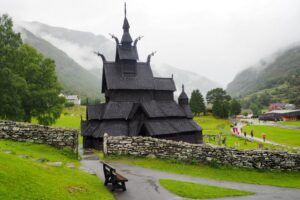
Borgund Stave Church, located in Norway, is a historic and well-preserved example of medieval wooden architecture that attracts tourists seeking a glimpse into the country’s rich cultural heritage.
Built in the 12th century, this stave church is not only one of the oldest historical sites but also one of the best-preserved of its kind in Norway; therefore, it is a must-visit destination for history enthusiasts and architecture tourists alike.
Visitors to Borgund Stave Church will be struck by its distinctive design, characterized by intricate wood carvings, steep gabled roofs, and a striking dragon motif on the roof ridge.
The church’s interior features a simple yet elegant layout, with a central nave and apse, as well as original medieval furnishings and decorations that have been carefully preserved over the centuries.
Guided tours of Borgund Stave Church are available for tourists who are not only looking to learn more about the history of this architectural gem but also its significance.
Knowledgeable guides provide insights into the church’s construction, its religious and cultural importance, and the unique features that set it apart from other stave churches in Norway.
Surrounded by picturesque natural scenery, Borgund Stave Church not only offers visitors a peaceful and serene atmosphere but also provides an ideal setting in which to explore and appreciate its historical significance.
Nearby hiking trails and scenic viewpoints provide opportunities for outdoor recreation and photography, making it an ideal destination for nature lovers as well.
In conclusion, Borgund Stave Church is a must-visit destination for tourists seeking to immerse themselves in Norway’s rich cultural heritage and architectural history.
Its well-preserved medieval design, stunning wood carvings, and tranquil surroundings make it a truly unique and memorable experience for visitors of all ages.
8. Heddal Stave Church Norway
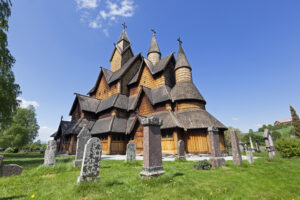
Heddal Stave Church, located in Norway, is a historic and culturally significant landmark that offers tourists a glimpse into the country’s rich architectural heritage. Built in the early 13th century,
Heddal Stave Church is not only the largest stave church in Norway, but it is also renowned for its intricate woodwork and medieval craftsmanship.
Visitors to Heddal Stave Church will be awed by its traditional Norwegian stave architecture, characterized by its wooden construction and distinctive dragon heads adorning the roof.
The church’s interior is equally impressive, with beautifully preserved frescoes, intricate carvings, and a serene atmosphere that transports visitors back in time.
Guided tours of Heddal Stave Church are available for tourists who are not only looking to learn more about the church’s history but also its significance
Knowledgeable guides provide insights into the church’s construction, its role in Norwegian religious and cultural traditions, and the stories behind its intricate carvings and decorations.
In addition to exploring the church itself, visitors can also wander through the surrounding grounds, which feature a picturesque cemetery and stunning views of the surrounding countryside.
The peaceful setting of Heddal Stave Church not only makes it a perfect place for quiet reflection but also provides an ideal environment for contemplation.
For those interested in purchasing souvenirs or learning more about Norwegian history and culture, a gift shop is located on-site, offering a variety of locally made crafts, books, and other items.
Overall, a visit to Heddal Stave Church is a must for tourists seeking to immerse themselves in Norway’s rich cultural heritage and experience the beauty of this historic architectural gem.
9. Kongsvinger Fortress Norway
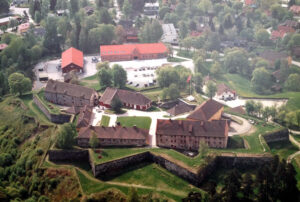
Kongsvinger Fortress, located in Norway, is a historic military stronghold that offers tourists a glimpse into the country’s rich past.
Built in the 17th century, the fortress served as a strategic defense post along the border with Sweden and played a significant role in Norway’s military history.
Visitors to Kongsvinger Fortress can explore its well-preserved ramparts, bastions, and buildings, which offer a fascinating insight into the architecture and military tactics of the time.
The fortress is surrounded by lush greenery; furthermore, it offers panoramic views of the surrounding countryside, making it a picturesque destination for both history enthusiasts and nature lovers alike.
Guided tours of Kongsvinger Fortress are available for tourists looking to learn more about its history and significance.
Knowledgeable guides provide insights into the fortress’s construction, its role in past conflicts, and the daily life of soldiers stationed there.
Visitors can also explore the fortress at their own pace, taking in the stunning views and imagining what life was like within its walls centuries ago.
In addition to its historical significance, Kongsvinger Fortress is home to a museum that showcases artifacts, weapons, and uniforms from the fortress’s past.
The museum offers a comprehensive overview of the fortress’s history and its importance in Norwegian military heritage.
After exploring the fortress, visitors can enjoy a leisurely stroll through the surrounding grounds, which feature walking paths, picnic areas, and scenic viewpoints.
Kongsvinger Fortress is a must-visit destination for tourists seeking a blend of history, culture, and natural beauty in Norway.
10. Lysefjord and Pulpit Rock (Preikestolen) Norway

Lysefjord and Pulpit Rock (Preikestolen) in Norway are iconic natural wonders that attract tourists from around the world.
Lysefjord is a breathtaking fjord located in southwestern Norway, known for its dramatic cliffs, crystal-clear waters, and stunning natural beauty.
The fjord stretches for about 42 kilometers and is surrounded by towering mountains that rise up to 1,000 meters above sea level.
One of the most famous attractions in Lysefjord is Pulpit Rock, also known as Preikestolen.
This flat-topped cliff stands 604 meters above the fjord and offers panoramic views of the surrounding landscape.
Visitors can hike to the top of Pulpit Rock, a relatively moderate 2-3 hour trek, to experience the awe-inspiring vistas and take in the sheer beauty of the Norwegian wilderness.
The hike to Pulpit Rock is a popular activity for outdoor enthusiasts and nature lovers, providing a unique opportunity to immerse oneself in the pristine natural surroundings of Norway.
The trail offers stunning views of the fjord, mountains, and lush greenery, making it a photographer’s paradise.
For tourists seeking adventure and a sense of accomplishment, a visit to Lysefjord and Pulpit Rock is a must-do experience.
Whether you are looking to challenge yourself with a hike to the top of the cliff or simply soak in the tranquility of the fjord from a boat tour,
Lysefjord and Pulpit Rock offer a truly unforgettable and awe-inspiring journey into the heart of Norway’s natural wonders.







